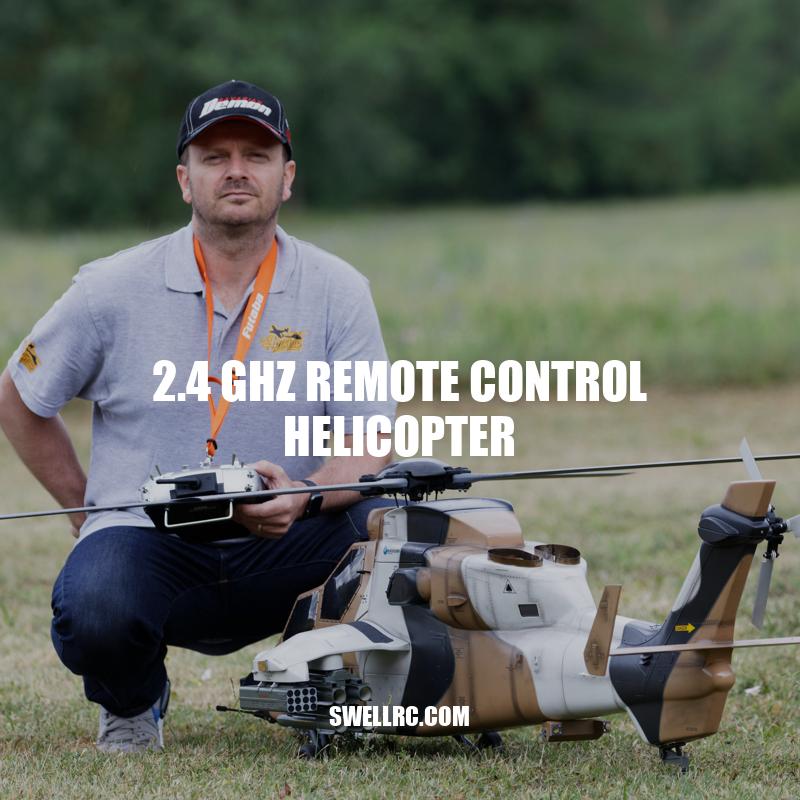Exploring 2.4 GHz Remote Control Helicopters: Features and Benefits
The 2.4 GHz remote control helicopter is a fascinating and fun device that allows hobbyists to experience the joys of flying a scaled-down version of a helicopter without leaving the ground. This type of model helicopter uses a specific radio frequency called 2.4 GHz, which is a relatively recent innovation compared to the older bands such as 27 MHz and 49 MHz. The 2.4 GHz technology has revolutionized the RC hobby industry by providing more stable and secure communication between the transmitter and the receiver of the helicopter, resulting in smoother and more accurate control over the flight. The frequency hopping spread spectrum (FHSS) and direct sequence spread spectrum (DSSS) modulation used in 2.4 GHz radios reduces interference from other RF sources and increases the number of channels for transmission, allowing multiple devices to work without interfering with each other. In addition, the higher speed and lower latency of 2.4 GHz make it easier to execute complex maneuvers and respond quickly to changing conditions, whether you’re flying indoors or outdoors. However, not all 2.4 GHz remote control helicopters are equally reliable, safe, or easy to use, and you need to do some research and compare different models to find the one that suits your needs and preferences. In the following sections, we’ll explore the various features and factors you should consider when selecting a 2.4 GHz remote control helicopter, from the compatibility of the transmitter to the durability of the frame, the range of the signal, and the battery life. By the end of this article, you’ll have a better understanding of how the 2.4 GHz remote control helicopter works and what to look for in a high-quality model.
What to Look for When Selecting a 2.4 GHz Remote Control Helicopter
When you’re shopping for a 2.4 GHz remote control helicopter, you should pay attention to the following features, specifications, and considerations:
- Compatibility with your transmitter: Make sure that the helicopter’s receiver is compatible with your transmitter, which might use a different protocol, firmware, or brand. Some 2.4 GHz helicopters use proprietary protocols that are not interchangeable with other brands, while others support more universal protocols such as DSM2, DSMX, S-FHSS, or FASST. Check the compatibility chart or user manual of both the helicopter and the transmitter to ensure that they can talk to each other. You can also choose to buy a ready-to-fly (RTF) package that includes a transmitter and receiver from the same manufacturer, but this option might limit your choices and budget.
- Frequency and channels: Although 2.4 GHz provides many channels for transmission, some models might use less than optimal frequencies or channels that are prone to interference from Wi-Fi routers, cordless phones, or other 2.4 GHz devices. Look for a helicopter that uses FHSS or DSSS modulation and avoids channels 11 and 26, which are often used for Wi-Fi and Bluetooth.
- Range and signal strength: Depending on your flying environment, you might need a helicopter with a longer or shorter range of operation. The range of 2.4 GHz remote control helicopters varies from under 100 meters to over 500 meters, depending on the type of antenna, power output, and noise immunity. However, keep in mind that the effective range can be affected by obstacles, interference, and weather conditions. Some helicopters also have adjustable signal strength settings that you can tune to the level of interference or the difficulty of the flight.
If you want to compare different models of 2.4 GHz remote control helicopters online, you can check out websites such as Amazon, HobbyKing, or Tower Hobbies, which offer a wide selection of products from various manufacturers. You can also read reviews and ratings from other customers to get an idea of the pros and cons of each model, or watch videos and tutorials on YouTube to see the helicopters in action. Additionally, you can consult forums, blogs, and social media groups dedicated to RC flying and ask for advice or recommendations from experienced pilots. By doing some research and comparing the features and prices of different helicopters, you can make an informed decision and find a 2.4 GHz remote control helicopter that meets your expectations and fits your budget.
What frequency is remote control helicopter?
Remote control helicopters typically use a radio frequency of 27 MHz, 49 MHz, or 2.4 GHz for communication between the transmitter and the receiver. Some models may utilize infrared radios instead. More information on specific frequency usage for different remote control helicopters can be found on manufacturer websites or product manuals.
Types of 2.4 GHz Remote Control Helicopters
There are different types of 2.4 GHz remote control helicopters available on the market, each with its own features, advantages, and limitations. Here are some of the most common types and their characteristics:
| Type | Description | Pros | Cons |
|---|---|---|---|
| Mini helicopter | A small and light helicopter that can be flown indoors or outdoors in calm conditions. Usually has coaxial rotors for stability and ease of use. | Easy to fly, affordable, portable | Short battery life, limited range, less precise control |
| Single rotor helicopter | A larger and more powerful helicopter that can perform more advanced aerial maneuvers and fly in windy conditions. Has a main rotor and a tail rotor for stability and direction. | More control, longer flight time, more realistic flight experience | Harder to fly, more expensive, more maintenance required |
| Collective pitch helicopter | An advanced and sophisticated helicopter that allows precise manipulation of the blades’ pitch angle for maximum lift and speed. Has multiple servos and motors to control the pitch, roll, yaw, and throttle of the helicopter. | High performance, realistic flight physics, customizable | Expensive, complex, requires advanced skills and experience |
Depending on your skill level, budget, and preferences, you can choose a 2.4 GHz remote control helicopter that suits your needs and goals. Keep in mind that some helicopters require more assembly, configuration, and tuning than others, and that some might have specialized features such as gyroscopes, LED lights, or camera mounts. You can browse the websites and catalogues of popular brands such as Syma, Blade, WLtoys, E-flite, or Align to see their offerings and compare their prices and specifications. You can also ask for advice and tips from hobby shops or online communities, or attend RC flying events to see different types of helicopters in action. Have fun exploring the world of 2.4 GHz remote control helicopters!
Keywords: 2.4 GHz remote control helicopter, types, mini helicopter, coaxial rotors, single rotor helicopter, tail rotor, collective pitch helicopter, servos, gyroscopes, LED lights, camera mount, Syma, Blade, WLtoys, E-flite, Align, aerial maneuvers, windy conditions, realistic flight experience, flight physics.
What are remote control helicopters called?
Remote control helicopters are also known as multirotor model helicopters. These helicopters have become increasingly popular in both the RC hobby and unmanned aerial vehicle research. They use an electronic control system and electronic sensors to stabilize the aircraft. For more information about RC helicopters, you can browse websites such as Hobbyking, Horizon Hobby or Tower Hobbies.
Conclusion
In conclusion, the 2.4 GHz remote control helicopter is a fascinating and entertaining hobby that can provide hours of fun and learning. Whether you’re a seasoned RC pilot or a newbie, you can benefit from the advanced technology and performance of the 2.4 GHz frequency band, which offers more stable and secure communication between the transmitter and the receiver, faster response times, and smoother controls. By choosing a compatible and reliable helicopter that suits your needs, budget, and skill level, you can explore the skies and test your flying skills in different environments and scenarios. Remember to follow safety guidelines, avoid flying near people, animals, or property, and respect the rules and regulations of your local authorities. Happy flying!
Keywords: 2.4 GHz remote control helicopter, hobby, learning, frequency band, communication, response times, controls, compatible, reliable, safety guidelines, rules and regulations.



